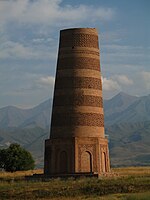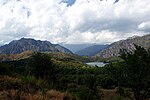List of World Heritage Sites in Kyrgyzstan
The United Nations Educational, Scientific and Cultural Organization (UNESCO) designates World Heritage Sites of outstanding universal value to cultural or natural heritage which have been nominated by countries which are signatories to the UNESCO World Heritage Convention, established in 1972.[1] Cultural heritage consists of monuments (such as architectural works, monumental sculptures, or inscriptions), groups of buildings, and sites (including archaeological sites). Natural features (consisting of physical and biological formations), geological and physiographical formations (including habitats of threatened species of animals and plants), and natural sites which are important from the point of view of science, conservation or natural beauty, are defined as natural heritage.[2] Kyrgyzstan ratified the convention on 3 July 1995.[3]
Kyrgyzstan has three sites on the list. The first site, the Sulayman Mountain, was listed in 2009. The Silk Road corridors were listed in 2014 and the most recent site, the Western Tien-Shan, was listed in 2016. The Sulayman Mountain and the Silk Roads are cultural sites, the Western Tien-Shan is a natural site. The Silk Roads site is shared with China and Kazakhstan while the Western Tien-Shan is shared with Kazakhstan and Uzbekistan. In addition, Kyrgyzstan has two sites on the tentative list.[3]
World Heritage Sites[edit]
UNESCO lists sites under ten criteria; each entry must meet at least one of the criteria. Criteria i through vi are cultural, and vii through x are natural.[4]
| Site | Image | Location (region) | Year listed | UNESCO data | Description |
|---|---|---|---|---|---|
| Sulaiman-Too Sacred Mountain | 
|
Osh | 2009 | 1230rev; ii, vi (cultural) | Located above the Fergana Valley on an important crossroads of the Silk Road, the Sulaiman-Too has been venerated as a sacred mountain in the pre-Islamic and Islamic times. There are numerous cult places on the slopes, including caves with petroglyphs that depict humans, animals, and geometric patterns. There are also two 16th century mosques.[5] |
| Silk Roads: the Routes Network of Chang'an-Tianshan Corridor* | 
|
Chüy | 2014 | 1442; ii, iii, v, vi (cultural) | Silk Road is an ancient network of trade routes that started forming in the 2nd century BCE and remained active until the 16th century. The roads connected societies of Asia, the Subcontinent, Central Asia, Western Asia, and the Near East. In addition to exchange of goods, they also contributed to the spread of technologies, ideologies, and religions, including Buddhism, Nestorian Christianity, Manichaeism, Zoroastrianism and early Islam. Several towns and supporting infrastructure have been constructed along the routes. This World Heritage site covers the corridors from Chang’an/Luoyang, the Han and Tang capitals of China, to the Zhetysu region of Central Asia, and is shared with China and Kazakhstan. Three properties in Kyrgyzstan are listed, the Burana Tower in Balasagun is pictured.[6] |
| Western Tien-Shan* | 
|
Jalal-Abad | 2016 | 1490; x (natural) | The property, shared with Kazakhstan and Uzbekistan, covers the western part of the Tian Shan mountain range. It is rich in biodiversity and a number of cultivated fruit crops originate from the area. Mountain peaks reach above 4,500 metres (14,800 ft). Four properties in Kyrgyzstan are listed, Sary-Chelek Nature Reserve is pictured.[7] |
Tentative list[edit]
In addition to sites inscribed on the World Heritage List, member states can maintain a list of tentative sites that they may consider for nomination. Nominations for the World Heritage List are only accepted if the site was previously listed on the tentative list.[8] Kyrgyzstan has two properties on its tentative list.[3]
| Site | Image | Location (region) | Year listed | UNESCO criteria | Description |
|---|---|---|---|---|---|
| Saimaly-Tash Petroglyphs | 
|
Jalal-Abad | 2001 | iii, iv, vi (natural) | The petroglyph site is located high in the Fergana Range. Over ten thousand stones with petroglyphs have been found so far, making it one of the richest sites of rock art worldwide. The earliest were created during the third millennium BCE. Saymaluu-Tash has been used as a sacred site at least until the Middle Ages. The petroglyphs provide inside into life and spiritual practices of people of Central Asia.[9] |
| Silk Roads Sites in Kyrgyzstan | 
|
several sites | 2001 | ii, iii, iv, v, vi (natural) | This nomination comprises six properties related to the Silk Road corridors in Kyrgyzstan. The sites in the Chüy Valley are already listed as a component of a World Heritage Site. Two main corridors were used. The road through the Fergana Valley was used during the Han Dynasty and Zhang Qian wrote about it in the 2nd century BCE. The route via the Bedel Pass and along the southern shore of the Issyk-Kul lake became popular in the early Middle Ages because of unrest in Fergana. A mausoleum in Özgön, dating to the 11th and 12th centuries, is pictured.[10] |
References[edit]
- ^ "The World Heritage Convention". UNESCO World Heritage Centre. Archived from the original on 27 August 2016. Retrieved 21 September 2010.
- ^ "Convention Concerning the Protection of the World Cultural and Natural Heritage". UNESCO World Heritage Centre. Archived from the original on 1 February 2021. Retrieved 3 February 2021.
- ^ a b c "Kyrgyzstan". UNESCO World Heritage Centre. Archived from the original on 8 December 2005. Retrieved 21 January 2023.
- ^ "UNESCO World Heritage Centre – The Criteria for Selection". UNESCO World Heritage Centre. Archived from the original on 12 June 2016. Retrieved 17 August 2018.
- ^ "Sulaiman-Too Sacred Mountain". UNESCO World Heritage Centre. Archived from the original on 16 October 2021. Retrieved 16 October 2021.
- ^ "Silk Roads: the Routes Network of Chang'an-Tianshan Corridor". UNESCO World Heritage Centre. Archived from the original on 13 February 2021. Retrieved 16 October 2021.
- ^ "Western Tien-Shan". UNESCO World Heritage Centre. Archived from the original on 20 October 2021. Retrieved 16 October 2021.
- ^ "Tentative Lists". UNESCO World Heritage Centre. Archived from the original on 1 April 2016. Retrieved 7 October 2010.
- ^ "Saimaly-Tash Petroglyphs". UNESCO World Heritage Centre. Archived from the original on 24 February 2007. Retrieved 29 January 2023.
- ^ "Silk Roads Sites in Kyrgyzstan". UNESCO World Heritage Centre. Archived from the original on 3 June 2021. Retrieved 29 January 2023.


